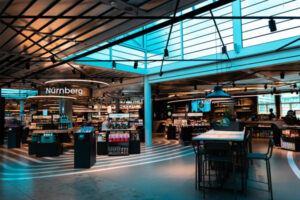By Lisa Quier Wagner
The entire world is in the grip of an unprecedented and yet largely invisible threat at the moment, and the level of uncertainty around it is as crippling as the situation itself. In a world that was already leaning in the direction of recession, this virus may be the tipping point toward financial calamity unless governments step forward decisively. This is widely predicted to come in the form of stimulus funding of historic proportions, but the details are as yet unknown, as is the duration of this crisis. As an industry, the outlet category has always matured during decades of upheaval, and we have routinely stated that “outlets are good in good times and great in terrible times.” 2020 may well test that theory.
It is important to remember that we have weathered such storms, albeit of varying magnitudes, before, and we have not only survived by thrived. At the very beginnings of the outlet industry in the United States, the combination of the stock market crash of 1989 and the S&L (Savings and Loan) crisis of 1991 was a nearly devastating blow to a nascent industry largely funded by S&L lending. A small number of key executives at the handful of outlet center development companies in the United States were able to quickly pivot and create relationships with new funding sources to meet the opportunity presented by a population seeking value and brands looking for expansion. The result was the first “golden age” of outlets in the early to mid-1990’s, with feverish openings of centers across the country and early entries into the UK market. This immediate recovery and rebound was possible because of an extraordinarily high level of cooperation and partnership between brands and the developers, resulting in coordinated rather than contradictory strategies, and consistency of messaging to the outside world.
We were challenged again as in industry and a people with the trauma of September 11, 2001. After initially reeling with the tragedy and terror of the attacks, life eventually went back to a new normal, punctuated by other momentary challenges such as SARS and sporadic upheavals caused by terrorism, natural disaster or the vagaries of the markets. During the majority of the 2000’s, the outlet industry’s biggest challenge in the US was the popularity of the new “lifestyle” and “town center” mixed use retail projects that were a byproduct of suburban housing sprawl, with inflated rents and overbuilt architectural showpieces created in what proved to be an unsustainable model. Once 2008 came along, that party was over. The financial crisis was the fuel for the next golden age of outlets, which included the US and Europe, and propelled us to where we are today as an industry. Built upon the rising tide of widespread and enduring consumer demand for quality and value, the outlet industry has flourished for over a decade on the heels of the financial meltdown, truly embodying that “when times are good” mantra.
And here we are, when times are terrible. How will the outlet industry fare this time? Having been in this industry long enough to recall that initial critical point in 1989 to 1991 and having gone through all of these other cycles, I think that we must draw upon the lessons of the past to predict and form our future. The key lesson from the first crisis? Coordination and cooperation, mixed with nimble financial maneuvering and a longterm view. The key lesson from the second major crisis? Meet and exceed consumer demand for brands and value while also creating a sense of place.
It is obvious to say that we must work together as occupiers and landlords, but the reality of that is challenged by a climate of self-interest unlike what we saw in the early 1990’s, as the investors in the category on both sides are less tolerant and more short-sighted. This position has to be amended to ensure the viability of the asset class. We have been dealt this hand at the same time and we need to work together to solve the problem rather than trying to shift the financial burden to one side or the other.
What will the consumer on the other side of this calamitous situation seek? Social scientists are predicting seismic changes in consumer behavior, some of which could be advantageous to our industry if we are coordinated in our efforts to address them, as we were in the 1990s. After weeks or perhaps months at home, consumers are experiencing what is referred to as “cocooning”, meaning that they are taking solace in their home environments. For some percentage of the population, the desire to emerge from their safe space will result in pent up demand to be among others, but will it be tempered by an enduring disinclination toward crowded spaces? Our open-air environments may be the perfect combination for those reluctant to enter mall spaces but eager to shop, but we need to remind consumers of that and invite those who have not patronized in the past. Will others be highly reluctant to leave the home and embrace even more fully e-commerce? An increased emphasis on the integration of the physical and digital spheres will be necessary to meet that nervous consumer. Is the move that we were witnessing toward mixed- use centers with entertainment venues likely to sputter or even stall? Should we be considering more exterior, park-like entertainment options in lieu of closed interior spaces? The unknowns outweigh the knowns at this point.
No matter how long this crisis situation drags on, it is clear that the economic impacts will be many, and the loss of income and wealth being felt by a significant portion of populations around the world, in spite of government aid, will have a resounding effect. Whether this tips us into recession is another unknown, but it is threatening. The devastating blow to tourism will be felt for some time to come no matter the overall economic climate. It is clear that consumer spending will be impacted, with predictions that value will again be paramount. This should position the outlet industry well, as it has in the past, but we must be ready with our proposition because all forms of commerce will be competing for the attention of emerging customers.
What we do know is that in crisis situations, businesses tend to fall into one of two categories: “adapters”who respond to changes, or “shapers” who assess the situation and model their own path toward survival. In the past, the outlet industry has adapted to a changing market rather organically. In this unprecedented situation, I would advocate that it is the shapers that will triumph. We as an industry need to come together to shape our future, mustering our collective strength as brands and brand curators, and lead a shaky population of consumers back out to our centers. I fully expect that the financial fallout of this calamity will return consumers back to a value mindset for a long time to come, and I believe that the outlet industry can shape our collective destiny by pulling together to orchestrate how we meet and exceed that demand and convey to a shaken world a sense of security and welcome. I believe that the next “golden age” of outlet development and expansion is in our near future if we work together to shape it.






